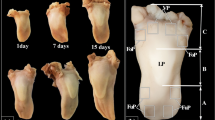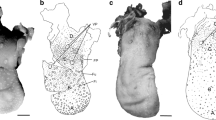Summary
In an attempt to find and reconstruct the exact anatomical correlate of taste sensitivity in the human soft palate, a novel approach was used to examine the mucosal surface in conjunction with serial tissue sectioning. Six human subjects, 15 to 29 years of age, 3 females and 3 males, served to take precision impressions of the hard and the anterior soft palate, using non-commercial trays and a self-curing resin. From these impressions, replicas were cast in Epon and subsequently sputtercoated with gold and examined in a scanning electron microscope. In addition, one biopsy was taken from one of the volunteers, in an area including taste bud-suspicious elements. It was found that the anterior soft palate mucosa included 10 to 30, oval to round, site-exotic islands, about 0.2–0.6 mm in diameter, which were covered by a thin, keratinizing stratified squamous epithelium. These islands occurred mainly in an area located in the central part of the soft palate, immediately posterior to the hard/soft palate boundary. The keratinizing epithelium of such islands carried four to seven taste buds which were lacking elsewhere. These islands were formed by a large, mushroom-like connective tissue papilla penetrating most of the site-specific mucosal epithelium, with its cover of keratinizing epithelium, forming sharp external and internal cell-to-cell borderlines with the surrounding, non-keratinizing stratified squamous epithelium. These findings are discussed in relation to induction phenomena necessary to form such islands, and to the variable taste sensitivity detected clinically in this region.
Similar content being viewed by others
References
Arvidson K (1979) Location and variation in number of taste buds in human fungiform papillae. Scand J Dent Res 87:435–442
Arvidson K, Friberg U (1980) Taste: response and taste bud number in fungiform papillae. Science 209:807–808
Bernimoulin JP, Schroeder HE (1980) Changes in the differentiation pattern of oral mucosal epithelium following heterotopic connective tissue transplantation in man. Pathol Res Pract 166:290–312
Cleaton-Jones P (1975) Normal histology of the human soft palate. J Biol Bucc 3:265–276
Cleaton-Jones P (1976) An ultrastructural study of keratinized epithelia in the rat soft palate. J Anat 122:23–29
Collings VB (1974) Human taste response as a function of locus of stimulation on the tongue and soft palate. Percept Psychophysics 16:169–174
Ebner Vv (1902) Von den Geschmacksknospen. In: Kölliker A (ed) Handbuch der Gewebelehre des Menschen, 6th edn. Vol 3, Engelmann, Leipzig, pp 18–31
Gairns FW (1955) The sensory nerve endings of the human palate. Q J Exp Physiol 40:40–48
Grossmann B (1921) Über das Vorkommen von Geschmacksknospen an der Vorderwand der Pars laryngea pharyngis beim Menschen. Mschr Ohrenheilk Laryngo-Rhinol 55:1174–1186
Henkin RI (1970) Taste localization in man. In: Bosma JF (ed): Second symposium on Oral Sensation and Perception. Thomas, Springfield, pp 43–64
Henkin RI, Christiansen RL (1967) Taste localization on the tongue, palate, and pharynx of normal man. J Appl Physiol 22:316–320
Hoffmann A (1875) Über die Verbreitung der Geschmacksknospen beim Menschen. Virchow's Arch [A] 62:516–530
Hosley MAK, Hughes SE, Oakley B (1987a) Neural induction of taste buds. J Comp Neurol 260:224–232
Hosley MA, Hughes SE, Morton LL, Oakley B (1987b) A sensitive period for the neural induction of taste buds. J Neurosci 7:2075–2080
Iida M, Yoshioka I, Muto H (1983) Taste bud papillae on the retromolar mucosa of the rat, mouse and golden hamster. Acta Anat 117:374–381
Kaplick M (1953) Über Vorkommen, Verteilung und histologische Beziehungen der Geschmacksknospen am Munddach einiger Säuger, besonders der Nagetiere. Z Zellforsch Mikrosk Anat 38:571–590
Karnovsky MJ (1965) A formaldehyde-glutaraldehyde fixative of high osmolarity for use in electron microscopy. J Cell Biol 27:137A-138A
Karring T, Lang NP, Löe H (1975) The role of gingival connective tissue in determining epithelial differentiation. J Periodont Res 10:1–11
Kinnman E, Aldskogius H (1988) Collateral reinnervation of taste buds after chronic sensory denervation: a morphological study. J Comp Neurol 270:569–574
Klein PB, Schroeder HE (1979) Epithelial differentiation and taste buds in the soft palate of the monkey, Macaca irus. Cell Tissue Res 196:181–188
Kolmer W (1927) Geschmacksorgan. In: von Möllendorf W (ed) Handbuch der mikroskopischen Anatomie des Menschen, Vol III/1 Springer, Berlin, pp 154–191
Kullaa-Mikkonen A, Seilonen K, Seilonen A (1987) Quantitative study of human fungiform papillae and taste buds: variation with aging and in different morphological forms of the tongue. Gerodontics 3:131–135
Lalonde ER, Eglitis JA (1961) Number and distribution of taste buds on the epiglottis, pharynx, larynx, soft palate and uvula in a human newborn. Anat Rec 140:91–95
Luft JH (1961) Improvements in epoxy resin embedding methods. J Biophys Biochem Cytol 9:409–414
Märk W (1940) Besonderheiten im Vorkommen von Flimmerepithel, Drüsen und Geschmacksknospen in der menschlichen Mundhöhle. Z Mikrosk Anat Forsch 49:82–107
Miller IJ (1986) Variation in human fungiform taste bud densities among regions and subjects. Anat Rec 216:474–482
Miller IJ (1988) Human taste bud density across adult age groups. J Gerontology 43: B26-B30
Mizuno T, Yasugi S (1990) Susceptibility of epithelia to directive influences of mesenchymes during organogenesis: Uncoupling of morphogenesis and cytodifferentiation. Cell Differ Dev 31:151–159
Nilsson B (1977) Taste acuity of the human palate. I. Studies with electrogustometry and taste solutions on young adults. Acta Odontol Scand 35:51–62
Nilsson B (1979a) Taste acuity of the human palate. II. Studies with electrogustometry on subjects in different age groups. Acta Odontol Scand 37:217–234
Nilsson B (1979b) Taste acuity of the human palate. III. Studies with taste solutions on subjects in different age groups. Acta Odontol Scand 37:235–252
Nilsson B (1979c) The occurrence of taste buds in the palate of human adults as evidenced by light microscopy. Acta Odontol Scand 37:253–258
Ouhayoun JP, Sawaf MH, Goffaux JC, Etienne D, Forest N (1988) Re-epithelialization of a palatal connective tissue graft transplanted in a non-keratinized alveolar mucosa: a histological and biochemical study in humans. J Periodont Res 23:127–133
Patzelt V (1921) Die Ergebnisse einer Untersuchung über die Histologie und Histogenese der menschlichen Epiglottis unter besonderer Berücksichtigung der Metaplasiefrage. Anat Anzeiger 54:161–184
Ponzo (1907) Sulla presenza di organi del gusto nella parte laryngea della pharinge nel tratto cervicale dell'esofago e nel palato duro del feto umano. Anat Anz 31:570–575
Schaffer J (1897) Beiträge zur Histologie menschlicher Organe. IV. Zunge, V. Mundhöhle-Schlundkopf, VI. Oesophagus, VII. Cardia. Sitzber Akad Wiss Wien, Math-Naturw Kl III, 106:353–455
Schroeder HE, Rossinsky K, Müller W (1980) An established routine method for differential staining of epoxy-embedded tissue sections. Microsc Acta 83:111–116
Schroeder HE, Preisig E, Marinello CP (1985) Size of corneocytes and non-keratinized superficial cells of the human oral mucosa at different ages. J Biol Buccale 13:237–249
Schumacher S (1927) Der weiche Gaumen und das Zäpfchen. In: von Möllendorf W (ed) Handbuch der mikroskopischen Anatomie des Menschen. Vol. V/1 Springer, Berlin, pp 26–34
State FA, Hamed MS, El-Hashash MK, Gaber OM (1982) Trophic specificity of the gustatory fibers upon taste bud regeneration. Acta Anat 113:196–201
Wood PJ, Kraus BS (1962) Prenatal development of the human palate. Some histological observations. Arch Oral Biol 7:137–150
Zalewski AA (1969) Regeneration of taste buds after reinnervation by peripheral or central sensory fibres of vagal ganglia. Exp Neurol 25:429–437
Author information
Authors and Affiliations
Rights and permissions
About this article
Cite this article
Imfeld, T.N., Schroeder, H.E. Palatal taste buds in man: Topographical arrangement in islands of keratinized epithelium. Anat Embryol 185, 259–269 (1992). https://doi.org/10.1007/BF00211824
Accepted:
Issue Date:
DOI: https://doi.org/10.1007/BF00211824




